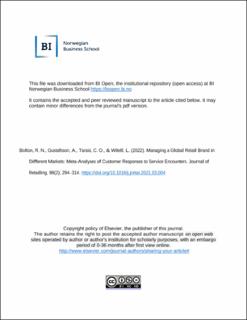Managing a Global Retail Brand in Different Markets: Meta-Analyses of Customer Responses to Service Encounters
Journal article, Peer reviewed
Accepted version
Permanent lenke
https://hdl.handle.net/11250/3028207Utgivelsesdato
2021Metadata
Vis full innførselSamlinger
- Scientific articles [2181]
Originalversjon
Journal of Retailing, Volume 98, Issue 2, June 2022, Pages 294-314 10.1016/j.jretai.2021.03.004Sammendrag
This study investigates how retailers can leverage their brand to shape customers’ satisfaction with service encounters. It develops and tests hypotheses about how brand, store, and consumer factors moderate customer responses to experience clues during retail service encounters. Six meta-regression analyses synthesize and compare results from 842 satisfaction equations describing customers’ encounters with a global retailer operating 400 stores in 32 countries. The results show how customers weigh their perceptions of service encounters differently depending on brand, store, and consumer factors. In markets where customers believe the retailer has high holistic brand quality, they place less weight on experience clues within the store. In markets where customers believe the retailer’s service brand promise, they place more weight on in-store experience clues. In markets where the retailer promises utilitarian value, customers weigh functional experience clues more heavily. In markets with an online purchasing channel, the effect of experience clues common to offline and online store environments is magnified, and unique clues are diminished. In addition, customers heavily weigh experience clues that fit their goals. In general, retail success factors include high brand quality (which makes customers more forgiving), a service brand promise that is mirrored in the store image (which makes customers attend to the experience clues aligned with them), and the careful monitoring and managing of retail touchpoints (to customize experience clues to each market). In this way, retailers can use customer-based strategies to effectively design and manage their global retail brand in different markets.

